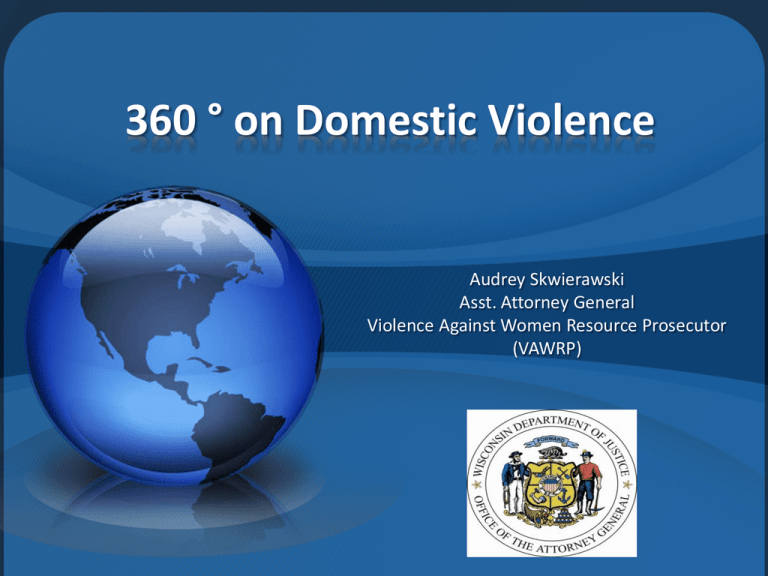360 Degrees on Domestic Violence
advertisement

360 ° on Domestic Violence Audrey Skwierawski Asst. Attorney General Violence Against Women Resource Prosecutor (VAWRP) Welcome Law Enforcement Prosecutors Corrections Advocacy Victim Services Health Care Thank you Thank you for the amazing work you continue to do to keep victims and families safe… And to hold perpetrators accountable Roadmap for DV cases ? Head on a swivel ? Quantifying DV Milwaukee County • Anywhere from 6,000 to 10,000 DV cases reviewed by District Attorney each year • Those are only the cases that get to the DA desk, many many more are investigated • And many more never get to the police in the first place Quantifying DV State of Wisconsin • The Wisconsin Coalition Against Domestic Violence (WCADV) released statistics related to state domestic violence homicides that took place in 2011. Forty people were killed in 34 incidents. Quantifying Domestic Violence as Significant Public Health Issue 50 – 57 % of women presenting at a health care system experience physical/emotional abuse in their lifetime Impact Affects Everyone in the House Impact Children exposed to DV • Behavioral, social, and emotional problems. Children in families experiencing domestic violence are more likely than other children to exhibit aggressive and antisocial behavior or to be depressed and anxious (Brown & Bzostek, 2003). Impact Children exposed to DV • Cognitive and attitudinal problems. Children exposed to domestic violence are more likely to experience difficulties in school and score lower on assessments of verbal, motor, and cognitive skills. • Slower cognitive development, lack of conflict resolution skills, limited problem solving skills, pro-violence attitudes are other issues identified in the research (Brown & Bzostek, 2003; Edleson, 2006). Impact Children exposed to DV • Long-term problems. Research indicates that males exposed to domestic violence as children are more likely to engage in domestic violence as adults; similarly, females are more likely to be victims (Brown & Bzostek, 2003). • Higher levels of adult depression and trauma symptoms also have been found (Silvern et al., 1995). Exposure to domestic violence is also one of several adverse childhood experiences (ACEs) that have been shown to contribute to premature death Not the good kind of recycling… Defining Domestic Violence • Use of coercive, controlling behavior backed up with physical, psychological, financial and sexual power tactics • Escalates in frequency and severity over time Defining Domestic Violence Wis. Stats. 968.075 968.075(1)(a) Defines domestic abuse as 1. Intentional infliction of physical pain, physical injury or illness 2. Intentional impairment of physical condition 3. A violation of 940.225(1), (2) or (3) [sexual assault] 4. A physical act that may cause the other person reasonably to fear imminent engagement in the conduct described in 1, 2 or 3 above Defining Domestic Violence Wis. Stats. 968.075 • An adult person against his or her spouse or former spouse, • An adult with whom the person resides or formerly resided • An adult with whom the person has a child in common What do we know about DV Victims Domestic violence affects victims regardless of : • • • • • • • • • • race religion gender/sexual identity culture social identification educational level age ability/disability immigration status economic status What do we know about DV Victims: Especially Vulnerable Populations • Women are much more likely to be victimized by a current or former intimate partner. • Women are 84 percent of spouse abuse victims and 86 percent of victims of abuse at the hands of a boyfriend or girlfriend • About three-fourths of the persons who commit family violence are male Especially Vulnerable Populations • Women age 16 to 24 are at the greatest risk of experiencing nonfatal intimate partner violence. • Initial studies indicate that: – Domestic violence is more often reported by the poor who rely on the police for dispute resolution – African American, American Indian and Alaska Native women experience the highest rates of intimate partner violence. Especially Vulnerable Populations • Compared to women without disabilities, women with disabilities are more likely to experience physical and sexual violence (Brownridge, 2006; Martin et al., 2006; Powers et al., 2002; Smith, 2008), increased severity of violence (Brownridge, 2006; Nannini, 2006; Nosek et al., 2001b), multiple forms of violence (Curry et al., 2004; Martin et al., 2006; Nosek et al., 2001a), and longer duration of violence (Nosek et al., 2001b). Interpersonal Violence and Women With Disabilities: A Research Update (11/08/2009) Laurie E. Powers, Rosemary B. Hughes, and Emily M. Lund. Dynamics of DV The Tale of the Frog in the Pot Dynamics of DV Power and Control Wheel If things don’t look or feel right… Beneath the surface there is more than meets the eye…. What we know about victims: Myths and Expectations • Why doesn’t she leave ? • Why does she recant or change her story? • Why doesn’t she want to prosecute ? Limited Choices • Which choice is the right one ? LEAVE FIGHT BACK STAND STILL Lola Tape What we know about victims: It is not in our nature to be “illogical” Trauma Response • Flight – Run Away! • Fight – Strike Back! • Freeze – Don’t Move! Psychological Trauma is a Neurobiological Injury • Impacts the limbic system yielding reduced hippocampal and amydalar volume; • Alters the production of stress hormones (I.e. cortisol) and neurotransmitters (epinephrine, dopamine, serotonin); • Diminishes integration between left and right hemispheres. TRAUMA REACTIONS • Loss of control; • Attempt to regain control & personal safety; • Perception or belief that individual is unable to defend or care for oneself; • Individuals reassert control by using coping strategies & problem solving skills based in previous experiences. IMPACT OF TRAUMA o Distortion of memory, time, worldview, safety, trust & reality… o Creation of confusion, chaos & the necessity of a survival response… IN THE SPLIT SECOND BEFORE THE SEMI-TRAILER SLAMS INTO YOUR VEHICLE, CAN YOU CALCULATE THE MASS, ACCELERATION & ANTICIPATED FORCE OF IMPACT? POSSIBLE BEHAVIORS DURING INTERVIEW • • • • • • • Hysterical Crying Screaming Unable to follow directions/confused Not providing details Calm Unaffected POSSIBLE BEHAVIORS DURING INTERVIEW • • • • • • • Uncooperative Hostile Angry Fearful Blaming Physically/Verbally Aggressive Refusing to talk Impact of DV Limited Options for the Victim • Even though our first reaction when hearing that someone is being abused might be “you should leave!” that is not always the safest advice to give. • When someone decides to leave an abusive relationship, the abuser can significantly increase the level of violence in order to maintain control. Impact of DV • • • • • Potential impacts on the victim Bureau of Child Welfare Loss of employment Poverty or homelessness Humiliation Frustration of family members and friends Loss of Control is Profound “For the researchers, the bottom line was that victim satisfaction in domestic violence cases appeared to hinge on the extent to which the victim felt control over ending the violence in the incident, control over her offender’s future conduct—and even over the criminal justice system. When the victim had a low sense of control, satisfaction with the system decreased significantly. “ NIJ Journal No. 253 • January 2006 The Victim Knows Best Victims know best about their own safety and well-being, and when they have a greater sense of control while working with agencies, they find the services more helpful and effective. • Zweig, Janine, Martha R. Burt, and Ashley Van Ness, Effects on Victims of Victim Service Programs Funded by the STOP Formula Grants Program, Washington, DC: U.S. Department of Justice, National Institute of Justice, 2003: 16 (NCJ 202903). What we know about abusers: • The majority of abusers are men – with national studies finding that women are the victims in as much as 85% of domestic violence incidents. What we know about abusers: Learned Behavior ? • Studies have found that nearly one half of abusive men grew up in homes where their father or step father was an abuser. What we know about abusers • Changing learned behaviors is HARD • A walk around the block won’t do it What we know about abusers • “Violent Individuals” theory = compelling evidence that many batterers are violent beyond domestic violence. • More accurately viewed as violent criminals, not solely as domestic batterers who are otherwise law-abiding in the “outside world” What we know about abusers • One study showed that more than 70% of offenders in jail for DV had prior convictions for other crimes. What we know about abusers • Offenders can be very calm, and persuasive at the scene. • Offenders use manipulation with their victims, and they are good at it. They will try to use these same skills with us. • Although some of the approaches we use for DV must be unique, we can apply techniques we acquire from other types of crimes Clip of Hospital DV New and Improved • Risk assessments and measurement tools that allow us to concentrate resources on worst offenders • Apply geographically based policing techniques • Where are the batterers? Where are the victims? Criminal Justice System ? • Who is holding the cards? • How many cards are we really holding? Redefine Success • Yes, investigation – prosecution – conviction are of critical importance • But big picture 360 examination = every opportunity counts • Every step of the process provides us with lifechanging moments to support the victim and provide negative consequences for abusers Interventions That Work • Layers of consequences for abusers – A study of more than 2,500 DV victims concluded that just the act of calling the police had a strong deterrent effect on re-victimization. – Arrest – Prosecution – Batterer’s intervention programming Interventions that Work • Layers of support for victims – Coordination in systems of support – Providing advocacy – Access to orders of protection – Safety planning – Ensuring feeling of control Every Intervention Can Be the One That Makes A Difference







